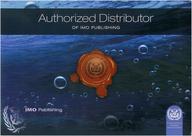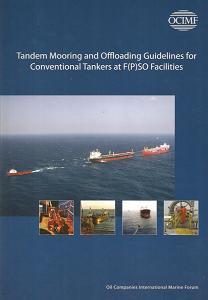Catálogo - LIBROS NÁUTICOS - Transporte marítimo, Fletamentos, Economía Marítima y Puertos
Tandem Mooring and Offloading Guidelines for Conventional Tankers at F(P)SO Facilities
Autor: OCIMF
Editorial: Witherby
Año de edición: 2.009
9781905331628
Encuadernación: cartoné
122 pág.
21,5 x 30,5 cm.
163,55€
Temporalmente sin existenccias
Contenido:
These guidelines address tandem mooring and cargo transfer operations of crude oil and other petroleum products between Floating (Production) Storage and Offloading facilities (F(P)SOs) and Conventional Tankers (CTs). F(P)SOs are increasingly being designed to accommodate CTs, as this permits increased flexibility in trading patterns for CTs and optimises field export freight economics without requiring dedicated or specialised shuttle tankers. These guidelines are intended to assist in improving equipment and procedures for CT tandem activities.
These guidelines are primarily intended to familiarise Masters, ship operators, F(P)SO Operators and project development teams with the general principles and equipment involved in F(P)SO – CT operations. Transfer of crude oil and petroleum products between an F(P)SO and a tandem moored Conventional Tanker (CT) has become commonplace in the shipping industry as Operators increasingly develop offshore fields without recourse to shore based export terminals. Experience gained from existing operations has proven that cargo transfer operations in a tandem mooring configuration may be undertaken safely and reliably. In order to address site-specific aspects in particular locations, the recommendations contained within this publication may be supplemented by additional requirements from development project teams, individual ship owners (or ship managers) and individual F(P)SO Operators. These Guidelines are intended to provide an understanding of the issues - including design, equipment, operations and environmental limitations in operation – contributing to a successful and safe tandem mooring and cargo transfer between an F(P)SO and a CT.
Índice:
SECTION 1. GLOSSARY OF TERMS AND ABBREVIATIONS
SECTION 2. INTRODUCTION
2.1 Scope
2.2 Purpose
2.3 Objectives
SECTION 3. APPLICABLE CODES AND STANDARDS
3.1 Regulatory Compliance
3.2 Classification Society (CS) Rules
3.3 Statutory Requirements
3.4 Coastal State/Local Requirements
3.5 Process Equipment Industry Standards and Guides
SECTION 4. FPSO, FSO AND OFFLOADING PHILOSOPHY
4.1 Definition and Application
4.2 Operating Environments
4.3 F(P)SO Subsea Mooring Arrangements
4.4 F(P)SO location relative to other structures
4.5 Basis of Design and Offloading Philosophy Development
SECTION 5. F(P)SO TANDEM MOORING CONFIGURATION AND EQUIPMENT
5.1 Introduction
5.2 Mooring Equipment Design
5.3 Single and Dual Hawser Mooring Systems
5.4 Mooring Equipment
SECTION 6. F(P)SO CARGO OFFLOADING CONFIGURATION AND EQUIPMENT
6.1 Configuration
6.2 Cargo Pumping System
6.3 Custody Transfer System
6.4 Manifold
6.5 Hose Flushing Arrangements
6.6 Cargo Hoses and Equipment
6.7 Quick Release Couplings
6.8 Hose End Fittings
6.9 Overpressure and Surge Protection
6.10 Cargo Containment
6.11 Lifting and Other Equipment
SECTION 7. CONVENTIONAL TANKER TANDEM MOORING AND LOADING CONFIGURATION AND EQUIPMENT
7.1 Conventional Tankers
7.2 CT Bow Mooring Equipment
7.3 CT Cargo Manifold
7.4 Position Keeping Equipment
7.5 Personnel Transfer Facilities
7.6 Lighting
7.7 Surge Prevention and Overpressure Protection
7.8 CT Equipment Maintenance and Repair
SECTION 8. MOORING FORCES AND RELATIVE MOTIONS
8.1 Introduction
8.2 CALM Buoy and Conventional Tanker
8.3 F(P)SO and Conventional Tanker
8.4 Simulation, Motions and Forces
SECTION 9. SUPPORT VESSELS, MANOEUVRING AND STATION KEEPING
9.1 Environmental Limitations for Tandem Mooring & Offloading
9.2 Requirements for Tugs and Support Vessels
9.4 CT Approach to the F(P)SO
9.5 Approach Speed
9.6 Station Keeping and Limiting Sectors During Offtake
9.7 Navigational and Berthing Aids
SECTION 10. TANDEM OFFLOADING OPERATION
10.1 Organisation and Responsibilities
10.2 Pre-Arrival Preparations
10.3 Pre-Mooring Preparations
10.4 Mooring Operation
10.5 Pre-Transfer Conference
10.6 Cargo Hose Connection
10.7 Cargo Transfer
10.8 Cargo Handling
10.9 Communication Requirements for Tandem Offloading
10.10 Disconnect and Un-Mooring
10.11 Night Operations
10.12 Manning and Watch Standing Operations
SECTION 11. RISK MANAGEMENT
11.1 CT Tandem Offload
11.2 Hazards and Effects Management Process
11.3 CT Tandem Offloading Hazard Identification
11.4 Risk Assessment
11.5 Risk Control
11.6 Mitigated Risk Assessment
11.7 Recovery Measures
SECTION 12. REFERENCES
Industry Guidelines
IMO Resolutions and Guidelines
Classification Rules
Mooring Systems
APPENDIX A
Offloading and Maintenance Philosophy
Precio: 163,55 €, I.V.A. incluido (4%)
[ Volver ]


